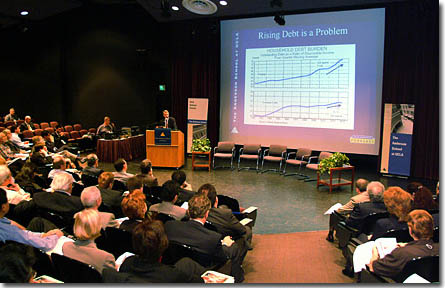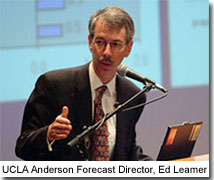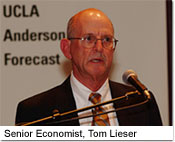|
 |
UCLA Anderson Forecast Still Predicting Short-term Sluggishness in National Economy;
State to Sputter in 2003;
Stall in Los Angeles Due to National Economic Slump
|
December 5, 2002
UCLA Anderson Forecast
|

|
LOS ANGELES — UCLA Anderson Forecast director Ed Leamer sees no reason to alter his most recent
prognostications and continues to forecast economic sluggishness and a disappointing national
labor market for at least another six months. The UCLA Anderson Forecast suggests that by mid-2003,
business investment may pick-up, but even long-awaited improvement in this essential sector will be
offset by a drop-off in consumer spending brought on by high debt loads.
 In a report titled, “No News Is No News,” Dr. Leamer notes that there have been no significant changes
in economic data to cause him to alter a forecast he has been making for most of 2002. In short, the
Anderson Forecast asserts that the current recovery cycle is part of the nation’s first “business cycle”
recession. In the past, drops in consumer activity have caused recessions; this time around it was steep
cuts in business investment brought about by the crash of the Internet Economy that caused a recession.
Like the unique “business recession,” we are currently experiencing a unique “business recovery,” as the
businesses try to sell off inflated inventory and in particular get more life out of technology investment
made in the late 1990s. When business begins to increase production (due to reduced inventory) and start
purchasing technology again, then the economy will pick up steam.
In a report titled, “No News Is No News,” Dr. Leamer notes that there have been no significant changes
in economic data to cause him to alter a forecast he has been making for most of 2002. In short, the
Anderson Forecast asserts that the current recovery cycle is part of the nation’s first “business cycle”
recession. In the past, drops in consumer activity have caused recessions; this time around it was steep
cuts in business investment brought about by the crash of the Internet Economy that caused a recession.
Like the unique “business recession,” we are currently experiencing a unique “business recovery,” as the
businesses try to sell off inflated inventory and in particular get more life out of technology investment
made in the late 1990s. When business begins to increase production (due to reduced inventory) and start
purchasing technology again, then the economy will pick up steam.
The caveat is that consumers have continued to spend as if there were no problems at all in the economy.
In large part, unusually low interest rates have spurred home and auto purchases. Dr. Leamer remains
concerned that large purchases made today due to low interest rates will ultimately result in less spending
in the future—basically saying that next year’s home and car purchases are being made today. The danger is
that consumer spending could potentially drop before business investing picks up speed.
“The real danger is that consumers’ high debt load slows spending before businesses ramp up production,”
said Dr. Leamer.
Dr. Leamer calls for a return to normal growth rates by the middle or end of 2003, when interest rates and
inflation will rise and unemployment will decline.
 In California, the news is actually not as good as it is for the nation. Senior Economist Tom Lieser warns
that the state is likely to move sideways throughout 2002, and then sputter during the first half of 2003. In California, the news is actually not as good as it is for the nation. Senior Economist Tom Lieser warns
that the state is likely to move sideways throughout 2002, and then sputter during the first half of 2003.
In his quarterly report titled, “The California Forecast: Looking for the Bottom,” Dr. Lieser comments that
the information technology industries (and their suppliers and distributors in California and across the
country) continue to suffer from substantial excess capacity and weak earnings. He also notes that major
employers in this key sector are unlikely to increase hiring until operations become profitable and many
companies are still undergoing staff reductions. In addition, there are other factors troubling the state’s
economic outlook, not the least of which is the state’s enormous budget deficit.
In other highlights from the California forecast, Dr. Lieser notes:
A downturn in export trade and continued slowing in consumer spending.
A belief that two areas of recent strength, auto and home sales, have passed their peak.
The health care industry is strong and remains unimpeded by the general recession.
Tourism is prevailing despite recent terrorist events.
Education has never been better for K-12.
Los Angeles County has slipped into an economic stall of its own. While Lieser’s state report demonstrates
that the Bay Area has fared far worse than Southern California since the Internet Crash, a report authored
by Senior Economist Christopher Thornberg suggests that the county as slipped into an economic stall,
despite having avoided the worst of the national recession up to this point.
Payroll employment in Los Angeles County has remained relatively flat for the past nine months. However, Dr.
Thornberg indicates that this flatness can be misleading. A closer look at the most recent data indicates
that formerly troubled sectors such as business services and the entertainment industry have given way to
new trouble spots—specifically retail trade and manufacturing. In fact, a revival in the motion picture
industry is one of the bright spots in the local economy, along with an end to the labor strife at the port.
Other indicators of business activity include:
Traffic through LAX and hotel occupancy rates are down.
International trade is slow.
Bankruptcies are up.
Dr. Thornberg forecasts a relatively weak Christmas retail season—up from last year, but still down from two
years ago.
About UCLA Anderson Forecast
The UCLA Anderson Forecast is one of the most widely watched and often-cited economic outlooks for
California and the nation, and was unique in predicting both the seriousness of the early-1990s downturn in
California, and the strength of the state’s rebound since 1993. Most recently, the Forecast is credited as
the first major U.S. group to declare the recession of 2001. Visit the UCLA Anderson Forecast on the Web at
http://uclaforecast.com.
|
|
|

